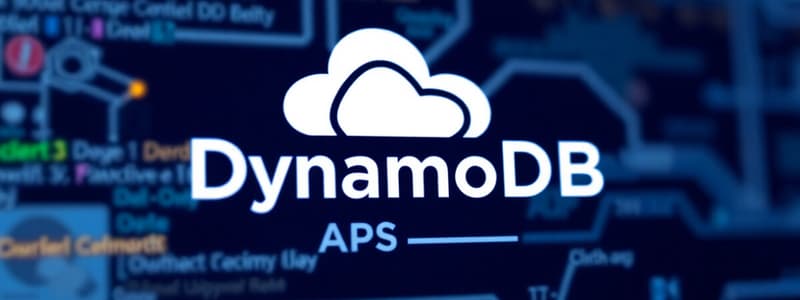Podcast
Questions and Answers
Which API operation primarily falls under the DynamoDB Control Plane?
Which API operation primarily falls under the DynamoDB Control Plane?
- PutItem
- GetItem
- DeleteItem
- UpdateTable (correct)
An application needs to retrieve a single item from a DynamoDB table. Which type of API operation should be used?
An application needs to retrieve a single item from a DynamoDB table. Which type of API operation should be used?
- Control Plane
- DynamoDB Transactions
- Data Plane (correct)
- DynamoDB Streams API
Which of the following scenarios is best suited for using DynamoDB Streams APIs?
Which of the following scenarios is best suited for using DynamoDB Streams APIs?
- Capturing and reacting to real-time data changes in a table. (correct)
- Performing bulk data uploads.
- Executing multiple, all-or-nothing operations.
- Modifying table schemas.
In what situation would the use of DynamoDB Transactions be most appropriate?
In what situation would the use of DynamoDB Transactions be most appropriate?
What is the primary purpose of the DynamoDB Control Plane APIs?
What is the primary purpose of the DynamoDB Control Plane APIs?
When should you consider using the BatchWriteItem API in DynamoDB?
When should you consider using the BatchWriteItem API in DynamoDB?
An application requires an audit trail of all changes made to a DynamoDB table. Which DynamoDB feature would best support this requirement?
An application requires an audit trail of all changes made to a DynamoDB table. Which DynamoDB feature would best support this requirement?
A financial application needs to transfer funds between two accounts, ensuring that both the debit from one account and the credit to the other either succeed or fail together. Which DynamoDB feature is most suitable for this?
A financial application needs to transfer funds between two accounts, ensuring that both the debit from one account and the credit to the other either succeed or fail together. Which DynamoDB feature is most suitable for this?
Which of the following scenarios best illustrates the use of TransactWriteItems in DynamoDB?
Which of the following scenarios best illustrates the use of TransactWriteItems in DynamoDB?
How does DynamoDB Streams differ from DynamoDB Transactions in handling data consistency?
How does DynamoDB Streams differ from DynamoDB Transactions in handling data consistency?
In the context of DynamoDB, what is the primary focus of operations performed on the 'Control Plane'?
In the context of DynamoDB, what is the primary focus of operations performed on the 'Control Plane'?
A financial application requires processing transactions in real-time and updating multiple accounts. Which approach would be most suitable for ensuring data integrity and consistency across these operations?
A financial application requires processing transactions in real-time and updating multiple accounts. Which approach would be most suitable for ensuring data integrity and consistency across these operations?
Which of the following is a key limitation of DynamoDB Transactions regarding the scope of operations?
Which of the following is a key limitation of DynamoDB Transactions regarding the scope of operations?
A media streaming service wants to track user viewing habits and trigger personalized content recommendations in real-time. Which DynamoDB feature would be most appropriate for capturing and processing user activity data?
A media streaming service wants to track user viewing habits and trigger personalized content recommendations in real-time. Which DynamoDB feature would be most appropriate for capturing and processing user activity data?
What role do IAM policies play in the context of DynamoDB Streams and Transactions?
What role do IAM policies play in the context of DynamoDB Streams and Transactions?
Which of the following scenarios requires the use of DynamoDB Transactions to ensure data integrity?
Which of the following scenarios requires the use of DynamoDB Transactions to ensure data integrity?
A gaming company wants to keep track of high scores and award badges to players in real time, they decide to capture and record every in-game action, which DynamoDB feature would be most appropriate to implement this?
A gaming company wants to keep track of high scores and award badges to players in real time, they decide to capture and record every in-game action, which DynamoDB feature would be most appropriate to implement this?
Which of the following operations is managed by the DynamoDB control plane?
Which of the following operations is managed by the DynamoDB control plane?
Flashcards
DynamoDB Control Plane
DynamoDB Control Plane
Set of APIs for managing DynamoDB tables and configurations.
DynamoDB Data Plane
DynamoDB Data Plane
Set of APIs for performing CRUD operations on data within DynamoDB tables.
DynamoDB Streams APIs
DynamoDB Streams APIs
APIs used to capture changes to items in a DynamoDB table.
DynamoDB Transactions
DynamoDB Transactions
Signup and view all the flashcards
Control Plane Purpose
Control Plane Purpose
Signup and view all the flashcards
Data Plane Purpose
Data Plane Purpose
Signup and view all the flashcards
Control Plane Use Case
Control Plane Use Case
Signup and view all the flashcards
DynamoDB Streams Use Case
DynamoDB Streams Use Case
Signup and view all the flashcards
DynamoDB Streams
DynamoDB Streams
Signup and view all the flashcards
Atomicity (in Transactions)
Atomicity (in Transactions)
Signup and view all the flashcards
Consistency (in Transactions)
Consistency (in Transactions)
Signup and view all the flashcards
Isolation (in Transactions)
Isolation (in Transactions)
Signup and view all the flashcards
Durability (in Transactions)
Durability (in Transactions)
Signup and view all the flashcards
Real-time Change Data Capture
Real-time Change Data Capture
Signup and view all the flashcards
TransactGetItems
TransactGetItems
Signup and view all the flashcards
Study Notes
- APIs facilitate programmatic interaction with DynamoDB.
- They enable the management of data within DynamoDB tables.
- Applications use simple API operations to interact with DynamoDB.
High-Level Operations
- Control Plane
- Data Plane
- DynamoDB Streams APIs
- Transactions
DynamoDB Control Plane
- Manages administrative tasks for tables, indexes, and configurations.
- Used for provisioning, scaling, security, monitoring, and backup.
- APIs include CreateTable, UpdateTable, DeleteTable, UpdateItem, DescribeTable, ListTables, etc.
- Indirect control over data through configuration.
- Not applicable for atomicity; focuses on administrative tasks.
- Configurations impact consistency levels (eventual vs. strong).
- Higher latency due to provisioning and configuration tasks.
- Secured via IAM policies to manage access to administrative actions.
- Does not directly access or modify data.
- Configures scaling settings, such as auto-scaling for throughput.
- Not applicable to real-time processing.
- Involves creating tables, modifying provisioned capacity, changing key schema, and managing IAM roles.
DynamoDB Data Plane
- Involves operations on actual data like CRUD (Create, Read, Update, Delete).
- Used for handling data retrieval, updates, and deletions.
- APIs include GetItem, PutItem, UpdateItem, DeleteItem, BatchGetItem, BatchWriteItem, etc.
- Directly manipulates and retrieves data items in tables.
- Not atomic unless wrapped in a transaction.
- Read and write consistency depends on the operation's configuration.
- Provides low latency for real-time data operations.
- Secured by IAM policies that govern access to data and CRUD operations.
- Direct access to data for reading and writing.
- Scalable based on table capacity or on-demand mode.
- Supports real-time CRUD operations on data.
- Involves inserting, updating, and retrieving data items from tables.
DynamoDB Streams APIs
- Captures changes to items in a DynamoDB table for application processing.
- Used for real-time event capturing for downstream processing (e.g., analytics, triggers).
- APIs include DescribeStream, GetShardIterator, GetRecords, etc.
- Captures data changes as events but does not directly modify data.
- Not atomic; captures changes over time in an event-driven manner.
- Stream data is eventually consistent, capturing changes after they occur.
- Provides low latency for capturing changes as they happen.
- Secured via IAM for access to Streams, monitoring, and reading records.
- Accesses changes in data captured by DynamoDB Streams but does not modify data.
- Scalable, depending on the volume of data changes captured in streams.
- Provides real-time change data capture for downstream systems like Lambda or analytics.
- Involves streaming changes to items for event-driven processing, such as notifying users of updates.
DynamoDB Transactions
- Executes multiple operations (CRUD) in a single, ACID-compliant transaction.
- Ensures atomicity, consistency, isolation, and durability (ACID) for complex operations.
- APIs include TransactGetItems and TransactWriteItems.
- Provides a way to perform multiple operations on items, ensuring all succeed or fail together.
- Atomic across multiple operations within a single transaction scope.
- Strong consistency is maintained within the transaction.
- Coordination adds overhead, but latency is low within the transaction.
- Secured via IAM policies to grant permissions for transaction-related actions.
- Allows access and modification of data in a transaction, ensuring consistency across all operations.
- Scalable, but transactions are limited to 25 items or 4 MB of data.
- Not for real-time processing but ensures consistency of data changes within a transaction.
- Involves transacting multiple operations in one request, like inserting and updating items, ensuring all are completed or none.
Key Differences
- The Control Plane manages infrastructure and configuration, while the Data Plane handles actual data operations.
- DynamoDB Streams captures and processes real-time changes without guaranteeing transactional consistency, while Transactions provide atomic operations across multiple items, ensuring ACID properties.
- DynamoDB Streams is designed for real-time change data capture for scenarios like real-time analytics or triggering workflows.
- DynamoDB Transactions allow for complex, consistent operations on multiple items, preserving data integrity, but are not real-time.
Studying That Suits You
Use AI to generate personalized quizzes and flashcards to suit your learning preferences.




